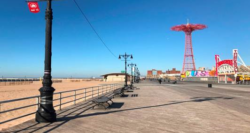
Coney Island Boardwalk. Image credit: LPC.
Iconic 2.7-mile long boardwalk designated for its cultural and historical significance, as little if any original fabric remains. On May 15, 2018, Landmarks voted to designate Brooklyn’s Coney Island Boardwalk a scenic landmark. The Boardwalk was originally opened to the public in 1923, and was extended in subsequent years. Under Robert Moses leadership of the Parks Department in 1938, the Boardwalk was straightened, moved inland, and extended. The Boardwalk’s current length is 2.7 miles. A 100-foot-wide corridor of sand below and adjoining the Boardwalk is included in the designation.
The Coney Island waterfront had been privately owned until the City acquire the land for the Boardwalk. With the opening of the Boardwalk, which was free to the public, people of all social classes gained access to waterfront and intermingled.
Landmarks Research Director Kate Lemos McHale noted that the Boardwalk was physically, culturally, and historically linked to other individual Landmarks, including the Cyclone, the Parachute Jump, the Wonder Wheel and the Childs Restaurant Building. Lemos McHale said the Boardwalk had long been a popular subject in art and popular culture, including in the “epic cult film” The Warriors. The Boardwalk plays host to the annual Mermaid Parade, a costume party celebrating the beginning of the summer season, as well as other smaller cultural events.
The Public Design Commission will retain binding authority over work on or to the Boardwalk, while Landmarks will oversee work primarily in an advisory capacity.
At an April hearing, residents, elected officials, and preservationist organizations endorsed designation. Many speakers, however, expressed a wish that Landmarks assert its authority, and exercise binding review of work to the Boardwalk, particularly the practice in recent years of replacing wooden planking with plastic and concrete. Council Member Mark Treyger, a driving force in the push to designate the Boardwalk, testified that the Parks Department and Public Design Commission had ignored the wishes of the local community and the Boardwalk’s users when failing to replace wooden boards in kind.
At the May meeting, Counsel Mark Silberman explained that the Commission’s oversight of City-owned properties was advisory, under a law passed in 1997 to prevent duplicative review between the Art Commission, now the Public Design Commission, and Landmarks. Landmarks would have binding oversight of existing buildings on the Boardwalk, such as comfort stations, where Landmarks was acting in lieu of the Design Commission, but not the Boardwalk itself or its furniture.
Commissioner Michael Devonshire said he was gratified to see the Boardwalk come forward to designation, and expressed his hope that other culturally iconic thoroughfares like the Bowery and Tin Pan Alley would be considered in the future. Commissioner Adi Shamir-Baron said the Boardwalk embodied the “communicativeness” Frederick Law Olmstead identified as the hallmark of an open society. Commissioner Kim Vauss shared fond memories of taking the D train to the end of the line to go to the beach as a child.
Chair Meenakshi Srinivasan said the Boardwalk was unparalleled as an icon and beloved public space, that had proved resilient both physically and in the public consciousness, and she was “thrilled” to bring it to a vote. Srinivasan said the boardwalk told an important story about government, space, and the public realm.
Landmarks voted unanimously to designate. The Boardwalk is the City’s eleventh scenic landmark.
LPC: Coney Island Boardwalk, Brooklyn (LP-2583) (May 15, 2018).
By: Jesse Denno (Jesse is a full-time staff writer at the Center for NYC Law.)

